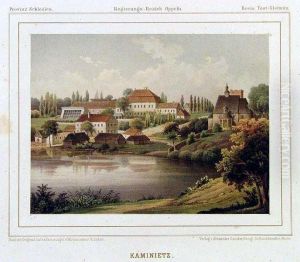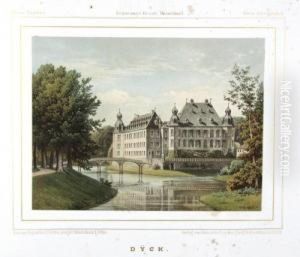Alexander Duncker Paintings
Alexander Duncker was a notable figure in the 19th-century German art and publishing worlds, born on February 18, 1813, in Berlin, Kingdom of Prussia, and died on August 23, 1897, in Bad Freienwalde, Germany. He was part of the prominent Duncker family and was known primarily for his contributions to lithography, publishing, and his passion for collecting and documenting architectural works.
Duncker's early life was marked by an immersion in the cultural and intellectual milieu of Prussia. He pursued his education with a focus on the arts and publishing, eventually taking over the family publishing business, Duncker & Humblot, which was established by his father and uncle. Under Alexander's leadership, the publishing house expanded its catalog to include a wide range of topics, from literature and history to the natural sciences.
However, Duncker is perhaps best remembered for his ambitious project, the 'Views of the Estates of the German Nobility' ('Sammlung von Ansichten der vornehmsten, im jetzigen Königreich Preußen gelegenen, Rittergüter'), a vast collection of lithographs that depicted the country estates and castles of the German aristocracy. Initiated in 1857 and continued until his death in 1897, this work was not only an artistic endeavor but also an important historical record, capturing the architectural styles and landscapes of the era.
Duncker's work in this collection exemplifies the use of lithography, a relatively new printmaking technique at the time, which allowed for the detailed and accurate reproduction of images. His dedication to the project reflected a broader interest in the preservation of cultural heritage, as well as an understanding of the power of visual imagery to convey the societal status and historical significance of these estates.
Throughout his life, Duncker was recognized for his contributions to the arts and publishing. His legacy is preserved not only through his publishing house, which continued to operate well into the 20th century, but also through the valuable collection of lithographs that offer a window into the architectural and cultural landscapes of 19th-century Germany. His work remains a valuable resource for historians, art historians, and anyone interested in the intersection of art, architecture, and history.

